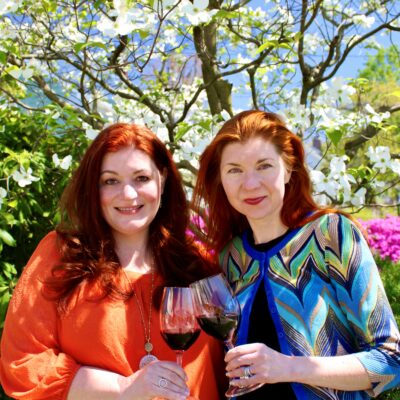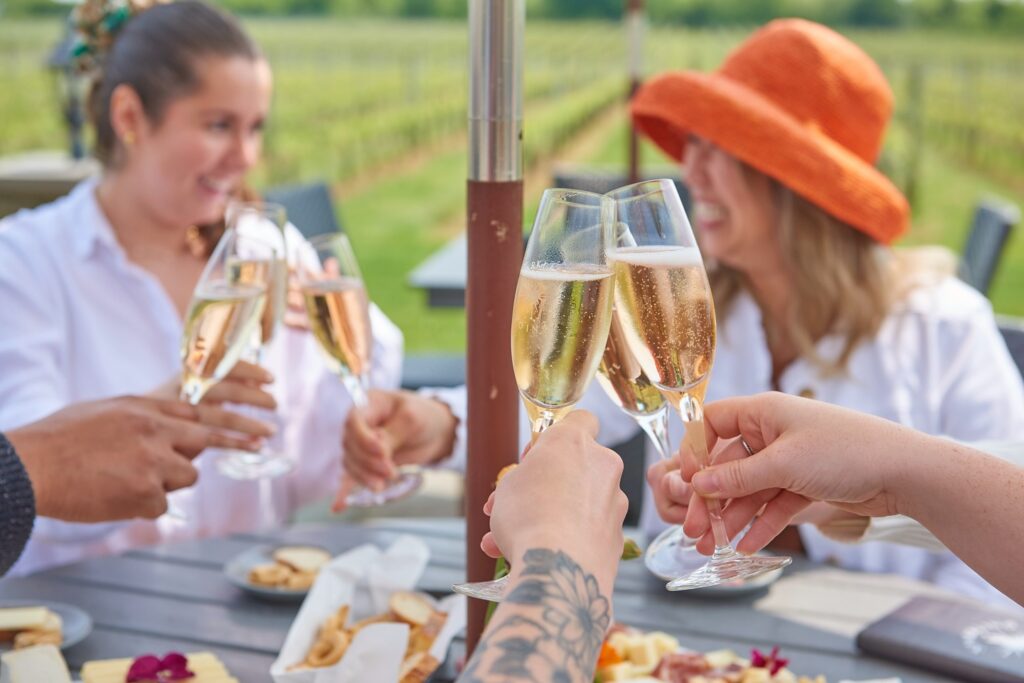
Champagne had a good run.
For centuries, fizz from France was the bottle to pop for celebrations large and small. But increasingly, winemakers across the world are producing sparkling wines in a range of styles—from a variety of grapes—and wine lovers can’t get enough of any of it. From the rarefied traditional method Blanc de Blancs to the unexpectedly exuberant and delightful offbeat Pet-Nats, and everything in between, wine drinkers are embracing it all..
The Empire State, with its long tradition of producing quality sparkling wines, the variety of grapes and its pioneering spirit, is the place aficionados and neophytes alike increasingly turn to when they’re thirsty for innovation and quality.
The first week of July is International Sparkling Wine Week, which just happens to coincide with the 248th anniversary of our country’s birth on July 4th. In other words, the perfect “excuse” to thoroughly explore New York wine country sparklers.
Classic Bubbles + New York Terroir
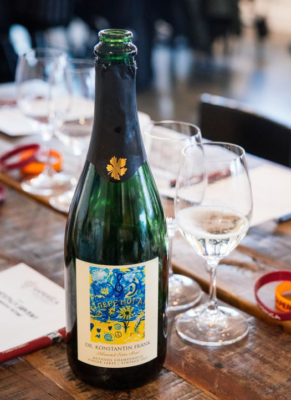
Traditional méthode (a.k.a. traditional method and méthode champenoise) sparkling wines, which are produced when still wine undergoes a second fermentation in the bottle that creates the “sparkle,” are made across New York State. Many producers opt to use the grapes that were historically deployed in Champagne to make these wines (Chardonnay, Pinot Noir and Pinot Meunier), but they also opt for other grapes that flourish in New York.
Dr. Konstantin Frank is synonymous with premium méthode champenoise in New York. The winery’s fourth-generation producer and vice president Meaghan Frank explains that her grandfather Willy created the first cuvee in 1985. (Willy also happens to be the first person brave enough to craft traditional sparklers from vinifera grapes like Chardonnay and Pinot Noir, and is widely considered to be the grandfather of traditional sparkling wine in New York.)
Today, the team—which includes winemaker Eric Bauman and Meghan’s aunt Barbara—creates traditional sparkling wines from Chardonnay, Riesling, Pinot Noir and Pinot Meunier. They’ve also been experimenting with Rkatsiteli, Gruner Veltliner, Pinot Gris, Pinot Blanc and Saperavi.
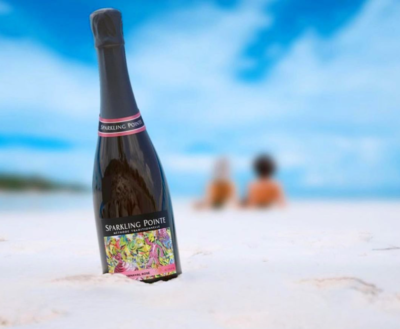 Southold’s Sparkling Pointe, founded in 2004 by husband-and-wife team Tom and Cynthia Rosicki does it all.
Southold’s Sparkling Pointe, founded in 2004 by husband-and-wife team Tom and Cynthia Rosicki does it all.
“We dedicated our vineyards to classic Champagne grape varieties, but we also have small plantings of Merlot and Muscat,” says Melissa Rockwell, director of consumer sales at the North Fork, Long Island estate winery.
The team at Sparkling Pointe sees that divergence from tradition as a trademark of the U.S. market more broadly, and a way for the winery specifically to celebrate its own distinct terroir.
“In the U.S. there is so much flexibility when it comes to grape variety and choice for winemaking,” Rockwell says. “Merlot is one of Long Island’s signature grapes, and when harvested early for méthode champenoise wine, it can be produced as a white wine that adds unique fruit character to the blends. As a red wine, it can be utilized for our very popular sparkling wine, Cuvée Carnaval Rouge.”
The Muscat, Rockwell says, adds floral aromatics to the demi-sec sparkling Cuvée Carnaval Blancs.
Chris Stamp, owner and winemaker at Lakewood Vineyards in Watkins Glen loves creating a classic traditional method wine from Chardonnay, Pinot Noir, or both.
“We use free run and lightly pressed juice from hand-harvested grapes,” Stamp says. “In the Finger Lakes, I particularly like the way the natural acidity and freshness show through in the glass.”
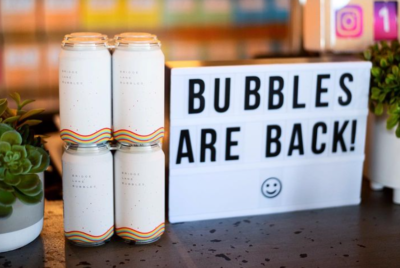 At Long Island’s Bridge Lane Wine Co., Ami Opisso agrees that traditional method wines made from grapes grown in the Empire State bear their own distinct stamp—and ideally, should be paired with local seafood.
At Long Island’s Bridge Lane Wine Co., Ami Opisso agrees that traditional method wines made from grapes grown in the Empire State bear their own distinct stamp—and ideally, should be paired with local seafood.
“They are refined, refreshing and pair perfectly with the fresh shellfish that can be sourced from our local Long Island waters,” Opisso says. “There’s no better pairing than fresh, briny oysters and a New York sparkling wine.”
Bridge Lane’s méthode champenoise wines include Bridge Lane Bubbles, made with Pinot Blanc and Chardonnay, and Bridge Bubble Rosé, made with Pinot Noir and Chardonnay.
Contemporary Bubbles + Fresh New York Flavors
Many of the winemakers who opt for traditional method sparklers, also have a penchant for a more contemporary spin on bubbles.
While Lakewood’s méthode champenoise may be a draw, Stamp confesses that many of the most serious somms—alongside more casual imbibers—eventually fall for Candeo.
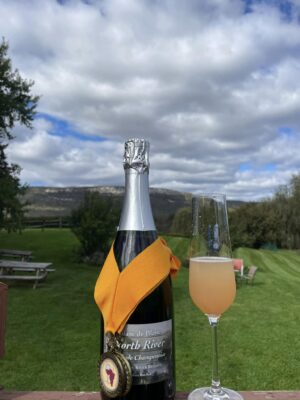
The newest fizz at Lakewood is made a la hard seltzer, except, as Stamp notes, “it tastes good.” The 375-ml bottle with a twist-off crown cap offers a low-ABV (7.5%) kick, and is ideal for a day at the beach, in the mountains or at a concert.
“This wine is made from free-run Cayuga White juice that is force carbonated,” Stamp explains. “It is fairly dry, but is released when it’s young and fresh, with a lightly fruit character reminiscent of Prosecco. It focuses on primary fruit characteristics—apple and citrus notes.”
The team at Whitecliff Vineyard & Winery in Gardiner has been making thoughtful grower-style méthode champenoise wines from Chardonnay and Pinot Noir since 2010, releasing long-aged cuvées to great acclaim. But this year, vintner Brad Martz released Whitecliff’s Pet-Nats, a Rosé made with Pet Nat and a 100% Vidal Blanc.
“We use all estate-grown grapes, starting with indigenous yeast fermentation and we don’t add sulfur,” Martz says. “I expect our Pet Nat portfolio to grow in the coming years, with a growth in the use of other hybrids.”
 At Channing Daughters Winery in Bridgehampton, winemaker and partner James Christopher Tracy focuses on sparklers made in the ancestral method, a.k.a. Petillant Naturel.
At Channing Daughters Winery in Bridgehampton, winemaker and partner James Christopher Tracy focuses on sparklers made in the ancestral method, a.k.a. Petillant Naturel.
Channing Daughter uses Chardonnay, Muscat, Pinot Grigio, Pinot Bianco, Tocai Friulano, Gewurtztraminer, Merlot, Cabernet Franc, Lagrein, Rofosco, Syrah, Blaufrankisch, Dornfelder and more in various cuvées.
“We release them anywhere from three to 24 months after bottling,” Tracy says. “We released our first Pet-Nat in 2013, and now we make between four and eight different sparklers every year. People love New York’s sparkling wines in many styles for their outstanding quality, and the bang for the buck they offer!”
Celebrating New York Made Sparkling Wine—Now
New York’s climate—hot days in the summer, cool nights—make it ideal for sparkling wine, especially with climate change, Whitecliff’s Martz says.
“We can achieve the quality we are looking for earlier in the season, harvest earlier and mitigate threats that can occur in New York as the season goes on,” Martz says. “I’m especially excited about our additional Pet Nat releases using hybrids. Because we’re celebrating our 25-year anniversary during Sparkling Wine Week, so we will be popping a lot of sparkling bottles with our customers.”
Other Empire State wineries are also poised to pop bubbles to celebrate Independence Day and Sparkling Wine Week.
“Konstantin would have been 125 years old so we will be raising a glass to his memory and his pioneering efforts on July 4th,” Meaghan says. “We actually celebrate sparkling wine every day at Dr. Frank’s though. We begin every tasting experience with our sparkling wine offerings. It is a way for us to honor our heritage.”

At Sparkling Pointe all through July and August, the winery will be offering guests the option to reserve an intimate sparkling wine and lobster roll picnic in the vines for two on weekends. Reservations will be offered at 11 am, 1 pm and 3 pm for sparkling wine tasting flights paired with lobster rolls, North Fork potato chips and water.
Lakewood will be honoring Sparkling Wine Week with a special bubbly flight featuring their Blanc de Noir, which is never normally available for flights in the tasting room.
“It’s the best way to add sparkle to the July 4th fireworks,” Stamp says.
We couldn’t agree more.

